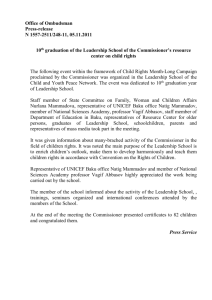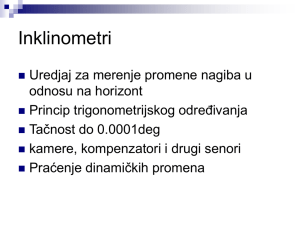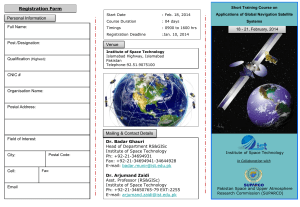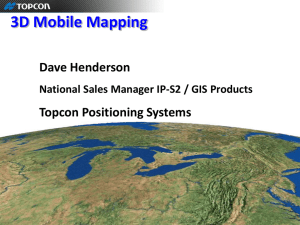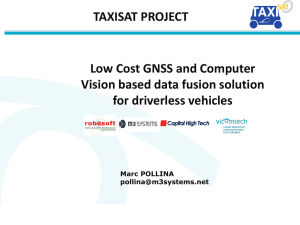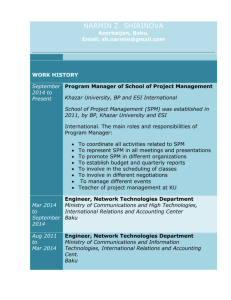Education tools for GNSS
advertisement
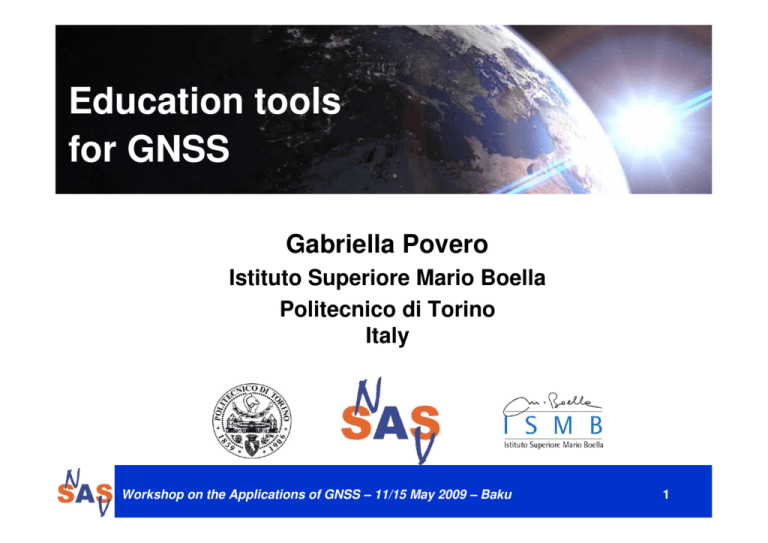
Education tools for GNSS Gabriella Povero Istituto Superiore Mario Boella Politecnico di Torino Italy Workshop on the Applications of GNSS – 11/15 May 2009 – Baku 1 NavSAS research group NavSAS is a joint research group of ISMB and Politecnico di Torino University operating in the satellite navigation and localization sectors. NavSAS staff consists of 28 researchers. Research is focused specifically on advanced technologies for GPS / EGNOS / Galileo receivers and applications. See http://www.navsas.eu & http://www.galileoblog.eu Workshop on the Applications of GNSS – 11/15 May 2009 – Baku 2 Outline 1 – Master on Navigation 2 – NAVKIT 3 – Signal Generator / Analysis 4 – Software receiver 5 – SAT SURF / SAT SURFER Workshop on the Applications of GNSS – 11/15 May 2009 – Baku 3 Master on Navigation and Related Applications The one-year Master is a joint initiative of with the cooperation of INRIM Galileo Ferraris and UN OOSA United Nations Office for Outer Space Affairs Workshop on the Applications of GNSS – 11/15 May 2009 – Baku 4 Structure of Education in Italy TheItalian Italian The Universitysystem system University after1999 1999 after Master II livello Specialising Master II level (1 year) Master I livello Specialising Master I level (1 year) Dottorato PhD (3 years) Laurea Specialistica Master of Science (2 years) Laurea Bachelor of Science (BS) (3 years) Pre-University Education (13 years) Workshop on the Applications of GNSS – 11/15 May 2009 – Baku 5 Specializing Master Master II livello Specialising Master II level (1 year) Master I livello Specialising Master I level (1 year) Dottorato PhD (3 years) Laurea Specialistica Master of Science (2 years) Laurea Bachelor of Science (BS) (3 years) Pre-University Education (13 years) Workshop on the Applications of GNSS – 11/15 May 2009 – Baku 6 Overview of the Master Program Studentswith withaa5-year 5-yearuniversity universitycurriculum curriculum Students Degreeon: on: Degree Information InformationTechnology Technology Requirements for Admission ElectronicEngineering Engineering Electronic CommunicationsEngineering Engineering Communications Aerospace AerospaceEngineering Engineering Environmental EnvironmentalEngineering Engineering Goodknowledge knowledgeof ofEnglish Englishlanguage language Good Workshop on the Applications of GNSS – 11/15 May 2009 – Baku 7 Overview of the Master Program The Masters lasts 1 year: 12 classes over 3 quarters (50 ECTS) The fourth quarter is devoted to an internship to be carried out in a company (30 ECTS) GNSS fundamentals Preparatory Receiver Technologies Applications Special Applications Pilot project Timing Pilot project 3 months in research lab or company Workshop on the Applications of GNSS – 11/15 May 2009 – Baku 8 Details on UN/Italy Fellowship “Istituto Superiore Mario Boella (ISMB) and Politecnico di Torino of Italy have established a Long Term Fellowship Programme which will provide scientists and specialists from developing countries with an opportunity to receive a Master Degree in Navigation and Related Applications.“ United Nations Vienna, June 2004 Thefellowship fellowshipisistherefore thereforethe thepossibility possibilityfor forstudents students The selectedby byUnited UnitedNations Nationsto toattend attendthe theMaster Master selected Workshop on the Applications of GNSS – 11/15 May 2009 – Baku 9 Details on UN/Italy Fellowship The agreement among Politecnico di Torino, ISMB and UN-OOSA covers the following aspects: Master Organization The Masters programme has been organised with the co-operation of officers of UN-OOSA Contribution to the Master Curriculum definition The program of the courses has been prepared by the Masters Scientific Committee and discussed with the UNOOSA representatives Master Promotion The Masters and the Fellowship initiatives are promoted through the UN web site and in all the UN Educational Centres in the world Workshop on the Applications of GNSS – 11/15 May 2009 – Baku 10 Details on UN/Italy Fellowship The agreement among Politecnico di Torino, ISMB and UN-OOSA covers the following aspects: Student Selection 4-5 students are selected yearly by UN through the UN Regional Educational Centres Financial Support The students that are selected by UN receive a scholarship by ISMB to attend the Master Workshop on the Applications of GNSS – 11/15 May 2009 – Baku 11 The first five editions UN/ISMB Project Country - Students Algeria - 1 Madagascar - 1 Egypt - 1 Mexico - 1 Georgia - 1 Mongolia - 1 Ghana - 1 Nigeria - 2 Haiti - 1 Pakistan - 3 Iran - 1 Sri Lanka - 1 Jordan - 1 Vietnam - 2 ASIAN-Zhong Guò Projects JEAGAL Project ALPIP-Meftia Projects Country Country Argentina - 4 Ecuador – 2 Brazil - 2 Mexico – 1 Colombia - 1 Peru - 1 China - 6 Vietnam - 4 Italian National funds Country Country Bangladesh - 1 France - 2 China - 3 China - 1 Italy - 16 Indonesia - 1 Colombia - 2 Lebanon – 1 Vietnam - 1 Ecuador – 2 Pakistan – 3 Workshop on the Applications of GNSS – 11/15 May 2009 – Baku 12 Some comments… • Students actively participate to the course activities • Seminars offered by industries and international bodies were enthusiastically welcome by the students • Students coming from so different countries and cultures succeeded in interact and integrate their experience with very positive results in intellectual and cultural exchanges • About all the graduated students are now working in the field Workshop on the Applications of GNSS – 11/15 May 2009 – Baku 13 Outline 1 – Master on Navigation 2 – NAVKIT 3 – Signal Generator / Analysis 4 – Software receiver 5 – SAT SURF / SAT SURFER Workshop on the Applications of GNSS – 11/15 May 2009 – Baku 14 What is NavKIT NAVKIT1.1 is a tool for autonomous training on satellite navigation subjects The tool can be accessed via Web (www.navsas.eu) or can be installed as an application on the PC NAVKIT1.1 is the output of a task of the ERIG project “Education Research and Innovation in GNSS” funded by the GNSS Supervisory Authority within the VI FP Workshop on the Applications of GNSS – 11/15 May 2009 – Baku 15 Synchronized slides Sections can be selected for play and replay Printable version of slides Workshop on the Applications of GNSS – 11/15 May 2009 – Baku Exercises & Questions 16 Exercises on positioning problems and processing of satellite signals Methodologies for problem solving Workshop on the Applications of GNSS – 11/15 May 2009 – Baku 17 Every Chapter has a test. The student can check its own preparation. Self-evaluation test for each chapter: - Number of correct answers - Time used For each wrong answer a reference to the proper section of the lessons is provided Workshop on the Applications of GNSS – 11/15 May 2009 – Baku 18 Section of questions and answers on general topics related to GNSS Contributions by experts Bibliography & Glossary Workshop on the Applications of GNSS – 11/15 May 2009 – Baku 19 Outline 1 – Master on Navigation 2 – NAVKIT 3 – Signal Generator / Analysis 4 – Software receiver 5 – SAT SURF / SAT SURFER Workshop on the Applications of GNSS – 11/15 May 2009 – Baku 20 SW package: Signal Generator SISGEN JAMGEN NOISEGEN RF section (not simulated) Signal RX BPF LNA LPF ADC LO The signal generator is a software package which simulates the received signal at the output of the frontend analog to digital converter Workshop on the Applications of GNSS – 11/15 May 2009 – Baku 21 21 SW package: Signal Generator GPS L1 L2 L5 L1C L2C Analysis Tools SIS Modulations Galileo E1-BOC E1-MBOC E5 E6 EGNOS Interference Intra/Inter-system interference (IS): one ore more signals among GPS, Galileo, and EGNOS; Multipath (MP): one ore more attenuated and delayed versions of the SIS; Narrowband interference (CW): continuous wave (CW) signal; Wideband interference (WB): wideband signal modeled as filtered white noise. Workshop on the Applications of GNSS – 11/15 May 2009 – Baku 22 Signal generator (student edition) The student edition of the Signal generator is available free of charge! Please contact Davide Margaria (davide.margaria@polito.it) Workshop on the Applications of GNSS – 11/15 May 2009 – Baku 23 Outline 1 – Master on Navigation 2 – NAVKIT 3 – Signal Generator / Analysis 4 – Software receiver 5 – SAT SURF / SAT SURFER Workshop on the Applications of GNSS – 11/15 May 2009 – Baku 24 N-GENE Software Receiver - - Position Accuracy: r.m.s<10 m using code-based measurements and without applying carrier smoothing techniques Time to First Fix in Cold Start mode lower than 45 seconds Up to 20 channels - GPS L1 8 bits quantization at a sampling rate of 17.5103 MHz - Galileo E1, GIOVE-A & GIOVE-B signals, upgradable to Multiplexed Binary Offset Code (MBOC) easily - EGNOS, WAAS &A-GPS Workshop on the Applications of GNSS – 11/15 May 2009 – Baku 25 Outline 1 – Master on Navigation 2 – NAVKIT 3 – Signal Generator / Analysis 4 – Software receiver 5 – SAT SURF / SAT SURFER Workshop on the Applications of GNSS – 11/15 May 2009 – Baku 26 SAT-SURF & SAT-SURFER A Tool for Hands-On Training on Satellite Navigation Workshop on the Applications of GNSS – 11/15 May 2009 – Baku 27 SAT-SURF & SURFER Features 1 – It allows to log all the raw GPS and GSM data (both binary and NMEA Protocols) 2 – It embeds different GPS modules depending on the user needs: • uBlox Modules • SiRF Modules 3 – Equipped with a quad-band GSM/GPRS modem (worldwide coverage) for NAV/COM integration 4 – Raw data storage in the various file formats for an easy post-processing: • ASCII, Excel® & MATLAB® files • RINEX 2/3 Log Workshop on the Applications of GNSS – 11/15 May 2009 – Baku 28 Contacts Gabriella Povero gabriella.povero@ismb.it www.navsas.eu Visit our non-official blog on Galileo! www.galileoblog.eu Workshop on the Applications of GNSS – 11/15 May 2009 – Baku 29 Thank you! Workshop on the Applications of GNSS – 11/15 May 2009 – Baku 30
